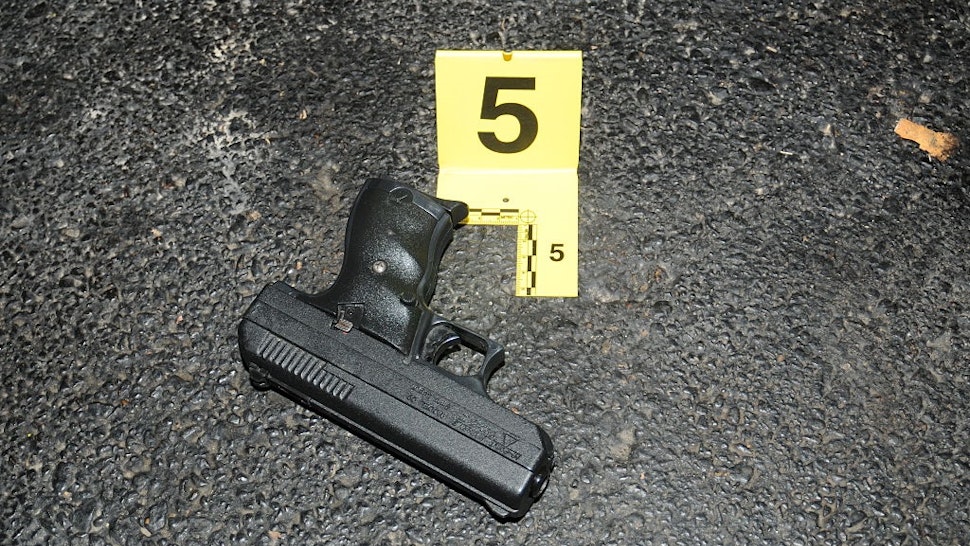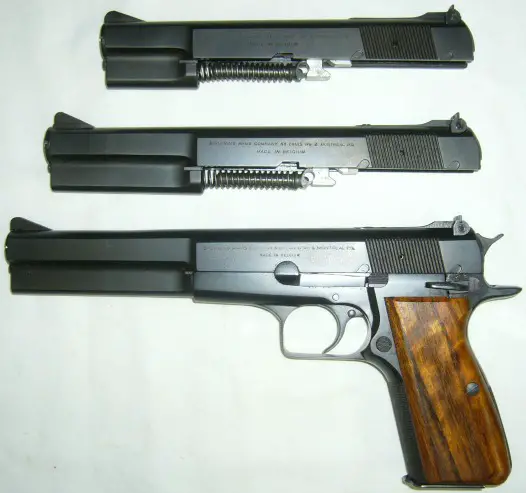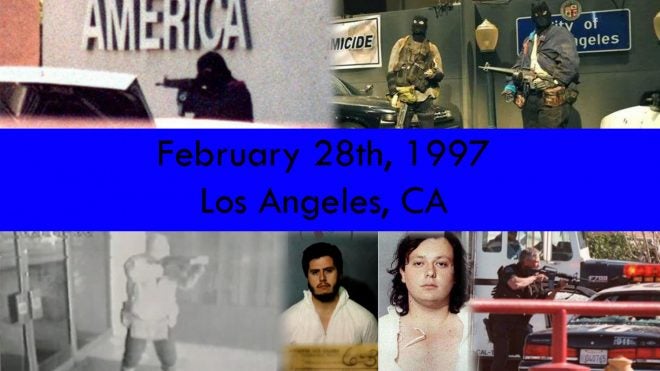
On Friday, February 28th, 1997 the Los Angeles Police Department would face one of the most dangerous criminal acts in its history – The North Hollywood Bank Shootout. On that Friday morning, after months of planning two armed bank robbers entered and robbed the North Hollywood Bank of America branch in California. The ensuing shootout between the heavily armed bank robbers and LAPD would go down in history as one of the largest gun battles in United States history. Today we’ll breakdown the facts leading up to and throughout the infamous North Hollywood Bank Shootout.
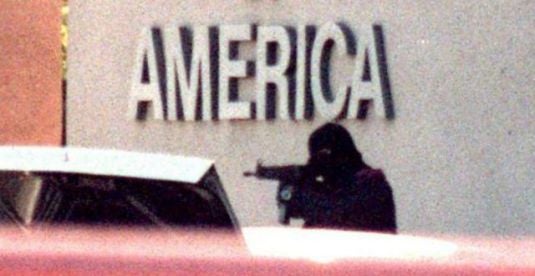
A Breakdown of the Infamous 1997 North Hollywood Bank Shootout
Disclaimer: This article is not intended to sit in judgment of any party that was involved in this incident. The purpose of this article is to take the facts which have been presented to the public to show readers a clinical, unbiased and truthful look at an unfortunate chain of events.
A Breakdown of the Infamous 1997 North Hollywood Bank Shootout
BEST-LAID PLANS
The robbers – Larry Eugene Phillips Jr. and Decebal Ștefan Emilian Mătăsăreanu – were familiar with firearms and prepared for the bank robbery by heavily arming and armoring themselves. Included in their arsenal were illegally modified rifles including two Norinco Type 56 S rifles, one Norinco Type 56 S-1 rifle and a Bushmaster XM15-ES2 Dissipator all of which were modified to be able to fire fully automatic. The robbers were also armed with an H&K Model 91 .308 rifle.
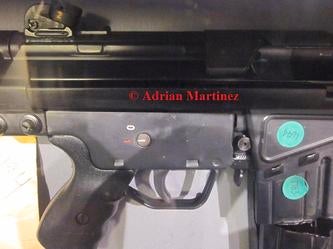
The HK-91 Rifle used by Phillips during the robbery (note the destroyed lower receiver and magazine)
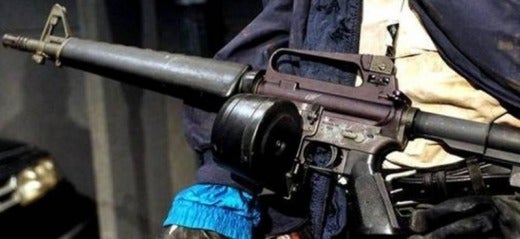
An illegally modified XM15 used by the robbers to fire fully-automatic – Beta mag attached
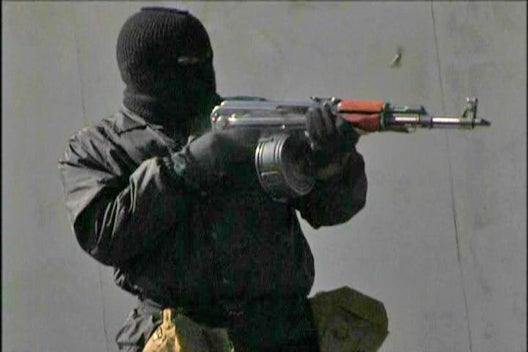
Norinco Type-56 Sporter modified to fire full-auto by the robbers – an attached Romanian 75 round drum magazine.
Phillips and Mătăsăreanu also armored themselves with varying degrees of body armor. Mătăsăreanu wore a Type IIIA bulletproof vest with a trauma plate to protect vital organs while Phillips was found to have worn more than 40 lbs of equipment including his armor. Phillips wore a Type IIIA vest which included a groin guard and he supplemented this with several pieces of homebrewed body armor salvaged from pieces of other vests. All together Phillips was nearly covered from head to toe in body armor.
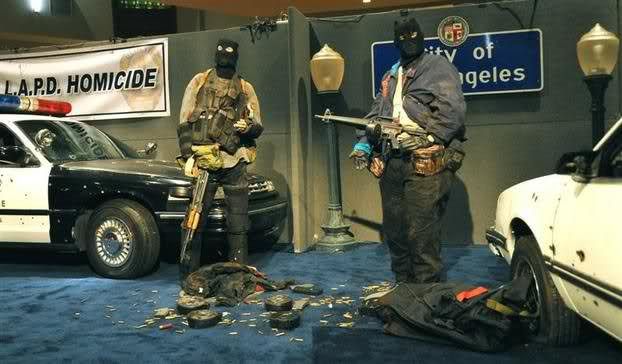
A Breakdown of the Infamous 1997 North Hollywood Bank Shootout: Recreation of Phillips (left) and Mătăsăreanu on the day of the robbery
In addition to their armament, both robbers made an extensive reconnaissance of the Bank located at 6600 Laurel Canyon Boulevard – this reconnaissance included finding the exact person they needed to gain access to the bank’s vault which was their main target. The robbers also made use of police scanners to determine the estimated response time and included watches sewn onto the back of their gloves to monitor their timing.
THE ROBBERY
At 9:17am the two robbers arrived at the bank and set their watch alarms for 8 minutes. As the two made their way into the bank they were spotted by two patrolling officers. Loren Farrel and Martin Perello were on patrol and driving down Laurel Canyon when they spotted the robbers. Perello immediately called in the possible 211 – the code for robbery.
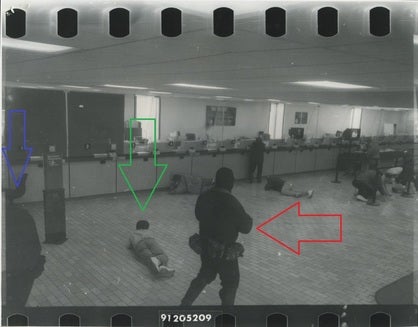
A Breakdown of the Infamous 1997 North Hollywood Bank Shootout
After entering the bank the robbers proceeded to harass both customers and bank employees. Mătăsăreanu opened fire into the bank’s ceiling declaring “This is a F*cking holdup!” As Phillips secured the main bank lobby Mătăsăreanu proceeded to track down the bank’s assistant manager John Viligrana.
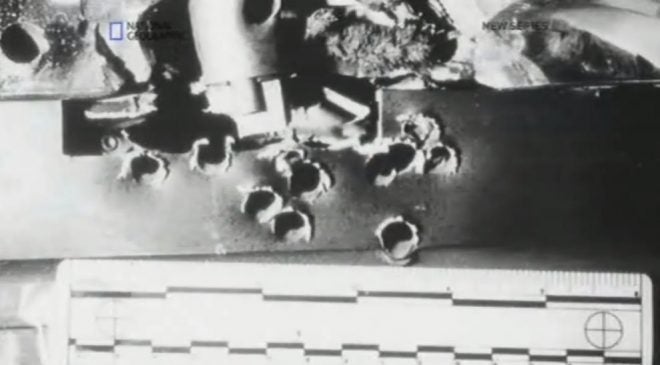
The metal door jam was shot along with the bullet-resistant glass leading to the tellers and bank vault.
Viligrana was located inside the tellers where the vault door was. To gain access to this area, Mătăsăreanu shot through the 1/4″ thick bullet-resistant polycarbonate and acrylic composite panels with his converted Norinco Type 56 Sporter rifle. The short burst destroyed the panels and riddled the striker plate with bullet holes.
John Villigrana encountered Phillips after he blasted the door open and was immediately met with demands to “Get the money or we kill you.” Even though Villigrana immediately complied with the demands he was still struck in the back of the head with the wire-frame stock of Phillip’s rifle.
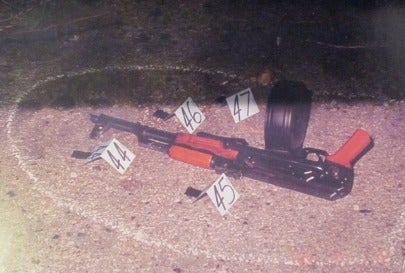
A Breakdown of the Infamous 1997 North Hollywood Bank Shootout
Upon entering the vault Villigrana began filling Mătăsăreanu’s bags with cash. However, due to a recent change in delivery times and practices, the bank had not yet received its bulk delivery and the amount of cash inside was not what the robbers had expected (roughly $750,000). Assistant Manager Villigrana recalls that Mătăsăreanu became visibly and audibly upset with this revelation. In a display of rage, Mătăsăreanu unloaded a full 75-round drum into one of the vault’s cash lockers (Burgher Box).

A Breakdown of the Infamous 1997 North Hollywood Bank Shootout
After this incident, Villigrana had finished loading up the robber’s bag with a total of $303,305 which included 3 dye packs that would all detonate as the robbers were leaving the building. With their 8 minutes up the robbers marshaled the terrified customers into the bank vault and at that point, Phillips exited the Northwest door of the building while Mătăsăreanu remained inside for another 4 minutes – it is still unknown what he did inside the bank during this time.
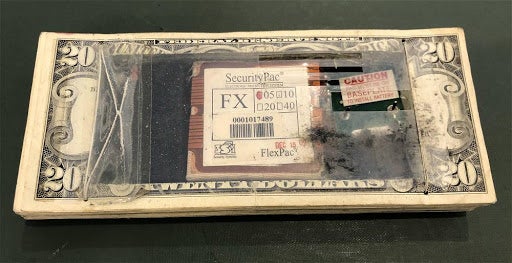
A Breakdown of the Infamous 1997 North Hollywood Bank Shootout
THE SHOOTOUT
During the bank robbery, LAPD officers had managed to surround the building setting up patrol cars along Laurel Canyon Boulevard as well as the intersecting streets surrounding the bank. Officers began to arrive only minutes after the initial two-eleven call was made by Officer Perello.
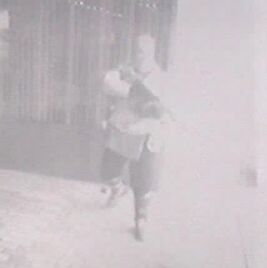
Phillips as he opened up with his initial barrage of fire at the LAPD
As Phillips exited the building he immediately encountered LAPD officers. Phillips opened fire with the first of what would eventually be 1,100 rounds reportedly fired by the robbers during the ongoing battle. LAPD Sgt. Haynes along with 3 other officers were the first targets of Phillips and the first barrage of full-auto fire riddled the police cruiser with bullet holes as the officers took cover. Phillips continued to pursue the officers and present civilians and even fired on the police helicopter AIR-8 which had arrived just seconds before Phillips exited the bank.
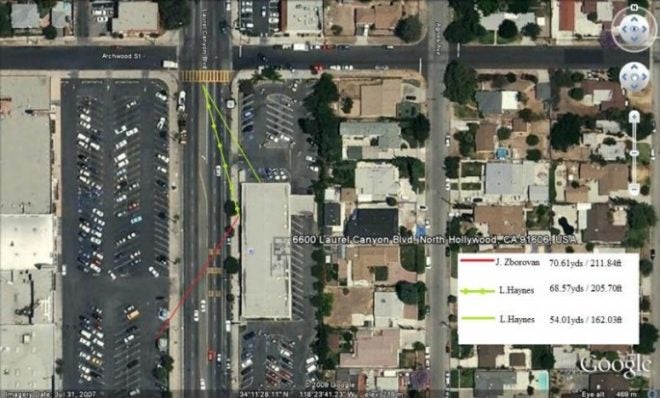
Although it may not seem like it the distances that the gunmen were engaging the officers at put officers armed with pistols at a significant disadvantage.
Phillips continued to fire till he emptied his 75-round drum and then proceeded to retreat to where he had exited the bank. Officers used this opportunity to return fire with their Beretta 92F 9mm pistols. Some other officers had S&W Model 15 revolvers and others brought Ithaca Model 37 shotguns to combat the robbers. Shortly after reloading, Phillips stepped out again and in a single 128-degree arc of fire, he wounded three police officers and one civilian.
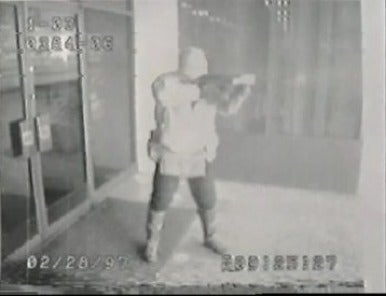
A Breakdown of the Infamous 1997 North Hollywood Bank Shootout
Phillips was initially shot by officer James Zboravan. Zboravan used his Ithica Model 37 and two blasts of buckshot to hit Phillips from the rear with 9 total projectiles but only one managed to injure Phillips by striking his right buttock which was unprotected by armor. Phillips turned to engage the officer and those around him and eventually wounded officer Zboravan with one round striking his lower back and other striking his hip and exiting through his thigh.
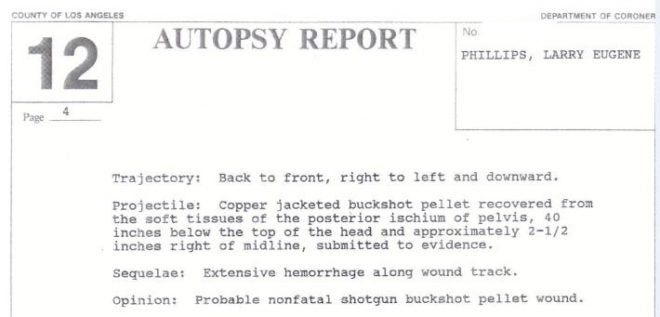

ATTEMPTED ESCAPE – PHILLIPS
This portion of the battle would go on between officers and Phillips until he decided to return to the bank Phillips may have been struck several times by both LAPD officers and detectives with 9mm rounds as several officers engaged him from multiple angles. After discarding several empty ammunition drums Phillips and Mătăsăreanu exited the bank both carrying the large money bag.
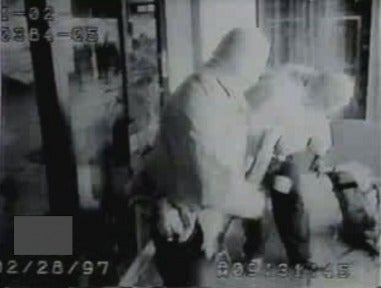
LAPD SWAT arrived 18 minutes after the shooting had begun and were much better armed than the patrol officers. LAPD SWAT brought AR-15 rifles to bear and commandeered a nearby armored truck to extract the wounded civilians and officers from the area.

LAPD officers and SWAT team members use a commandeered armored transport to rescue a wounded man, under fire from a robber at the Bank of America across the street. (Gene Blevins/Los Angeles Daily News)
As Mătăsăreanu and Phillips exited the bank and began to flee, Mătăsăreanu was shot twice in the right buttock and once in the left forearm which forced him to drop the bag of money which had been ruined by the detonation of the dye packs.
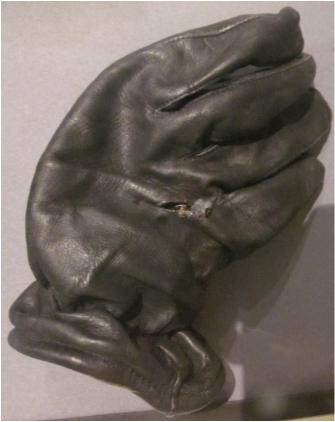
The glove from the right hand of Phillips
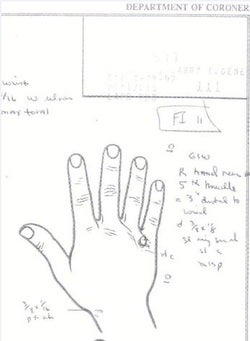
Autopsy report showing Phillips right hand which was shot
Mătăsăreanu then proceeded to enter their getaway vehicle and start the engine while Phillips retrieved the HK-91 from the trunk and continued firing at officers by walking along with the car as it moved. The HK-91 was struck on the receiver and magazine forcing Phillips to abandon the rifle. Phillips was simultaneously struck in the shoulder by officers.

A Breakdown of the Infamous 1997 North Hollywood Bank Shootout
Phillips quickly picked up a second Type 56 rifle and exited the parking lot and onto the street where Mătăsăreanu had driven the getaway vehicle. It is at this point that he continued to fire at police until his rifle jammed at which point he drew his Beretta 92FS and continued firing at police. Phillips was shot in the right hand which caused him to drop his pistol. After retrieving the pistol, Phillips chose to end his life with it while officers simultaneously shot him several times while the pistol was under his chin.
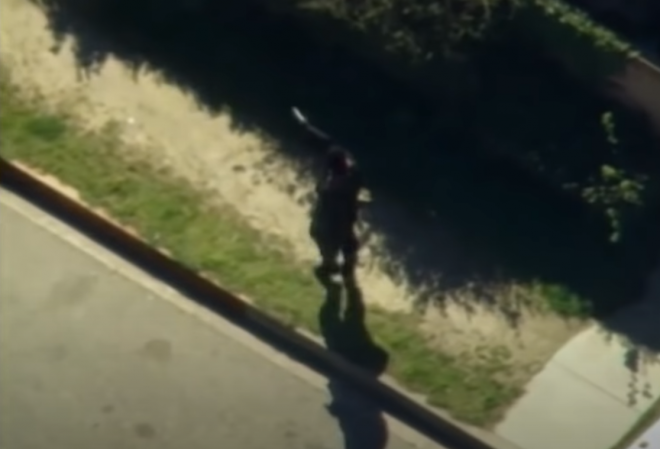
Phillips firing his Beretta 92FS at police shortly before his death.
ATTEMPTED ESCAPE – MĂTĂSĂREANU
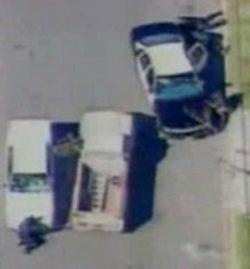
Mătăsăreanu continued down the street until the original getaway car was disabled by having two of its tires shot out. He attempted to steal a Jeep Gladiator by shooting at its driver. The driver ran away but not before activating the electrical kill switch which disabled the vehicle. As this was happening SWAT arrived and engaged Mătăsăreanu who had taken cover behind the original getaway car.

For almost the next two and a half minutes, there was a stream of near uninterrupted gunfire between the officers and Mătăsăreanu. The bank robber survived a direct “double-tap” to his vest and continued to fire at officers after catching his breath. Eventually, a swat officer chose to fire underneath the vehicles at Mătăsăreanu’s unprotected lower body which eventually wounded the bank robber and caused him to surrender, Mătăsăreanu put his hands up to indicate this.
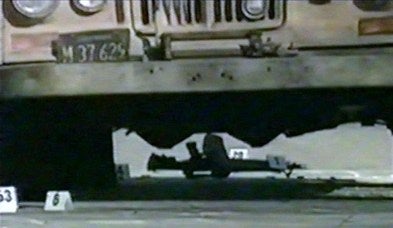
A Breakdown of the Infamous 1997 North Hollywood Bank Shootout
Just seconds after his surrender, police officers rushed to pin the man down and cuff him. Officers questioned him about his own name and if there were any other suspects and Mătăsăreanu reportedly retorted with a vulgar “F*ck you! Shoot me in the head!”
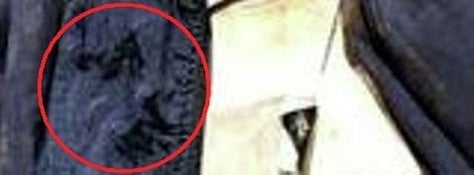
A photo of the “double-tap” shot sustained to Mătăsăreanu’s vest during the final exchange of gunfire.
Ambulance personnel, following standard procedure, refused to enter “the hot zone” where Mătăsăreanu was as he was still considered dangerous and there were reports that a third gunman might be on the loose. EMTs were not allowed to reach the scene until almost 70 minutes later after police radioed for an ambulance and Mătăsăreanu died at the scene from excessive blood loss. In total, he was shot over 20 times in the legs although the two fatal shots were from his left thigh.
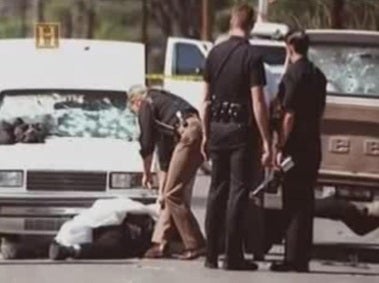
A Breakdown of the Infamous 1997 North Hollywood Bank Shootout
AFTERMATH – CONCLUSION
In just under 45 minutes, over 300 law enforcement officers had responded to the city-wide TAC alert. At that same time, over 1,100 rounds of various ammunition had been fired by just the robbers with an additional estimated 650 rounds fired by police. Miraculously the only two deaths were those of the two perpetrators. In total 11 police officers were wounded and 6 civilians were wounded during the 44-minute robbery.
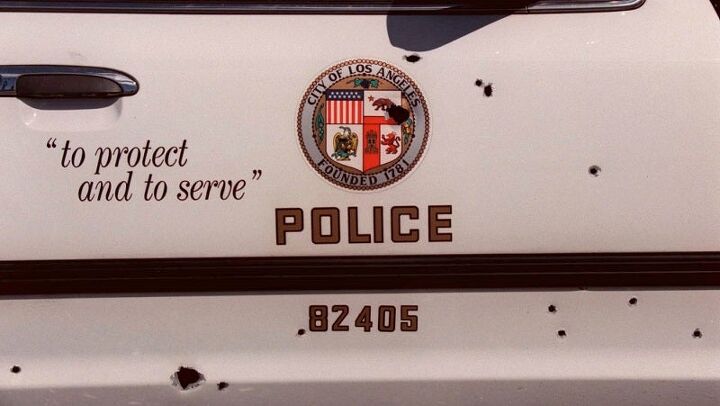
A Breakdown of the Infamous 1997 North Hollywood Bank Shootout
This single incident in which two heavily armed and highly motivated men chose to rob a bank at high risk proved to be one of the motivating factors to standard patrol officers being armed with more lethal weapons. If anything this incident proves just how ineffective standard patrol weapons (pistols and shotguns) can be against those with heavier firepower.
This thought process led to the Department of Defense giving 600 surplus M-16 rifles to the LAPD which were then issued to each patrol sergeant. Today weapons like these can be considered “standard issue” by many police departments.
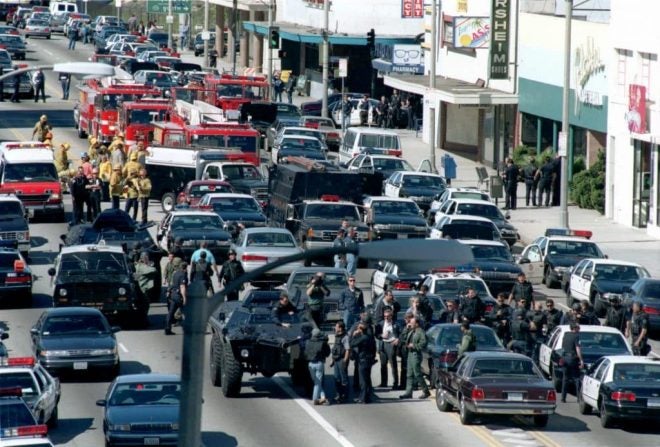
I hope that this brief breakdown of the facts has been informative and enjoyable to read. The story of the North Hollywood Bank shootout has many complex and intricate details, many of which I was not able to include for brevity’s sake. If you have questions many of the links in the article have a bounty of information that I was unable to include in the article. As always, thanks for reading and please feel free to leave a comment down below.
Photo Credits: CNN, National Geographic, Adrian Martinez, L. Mindham, LAPD Crime Scene Photos
































